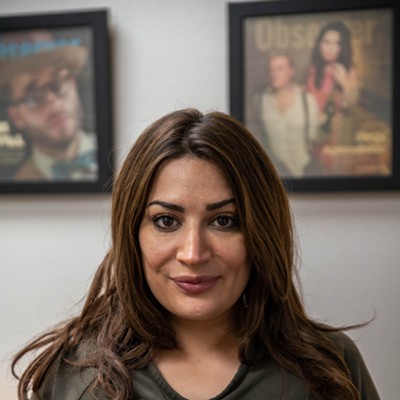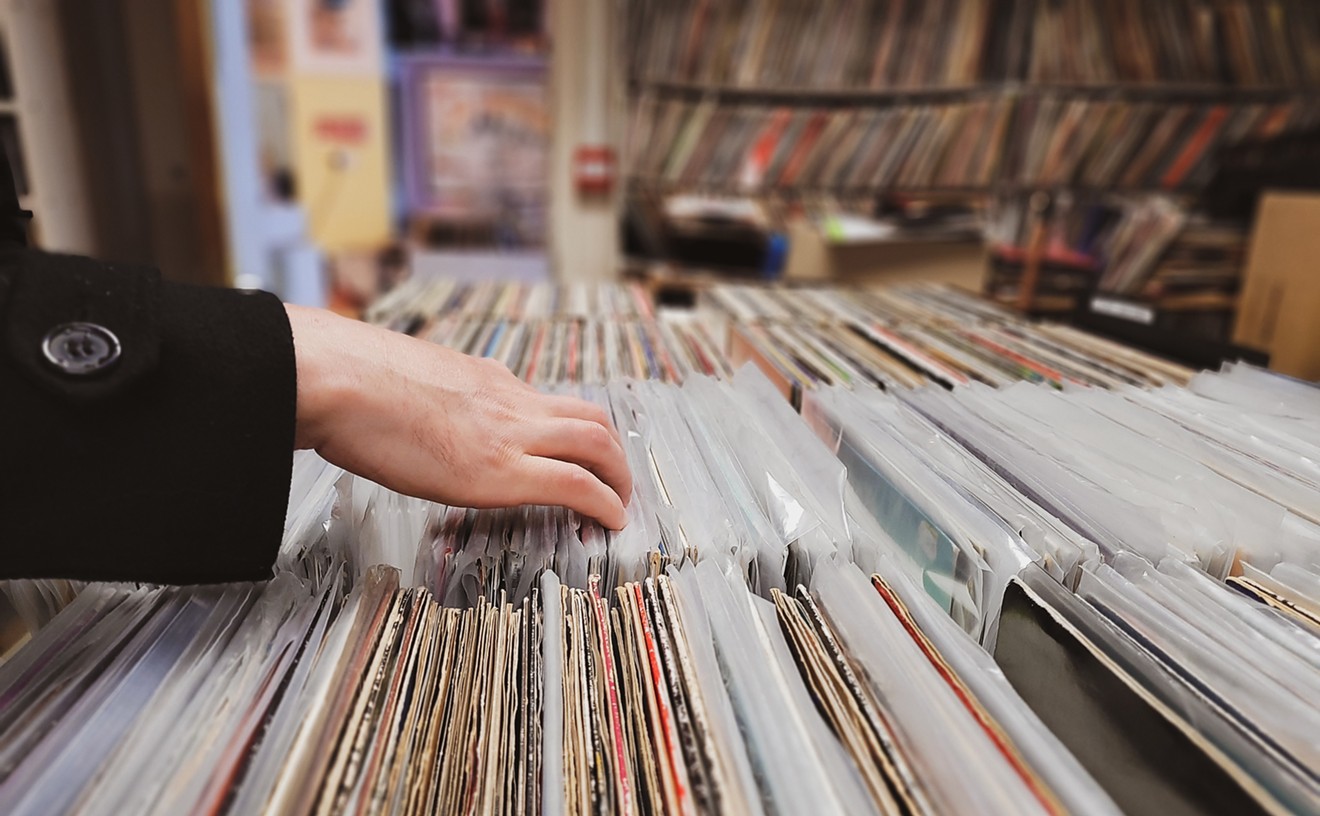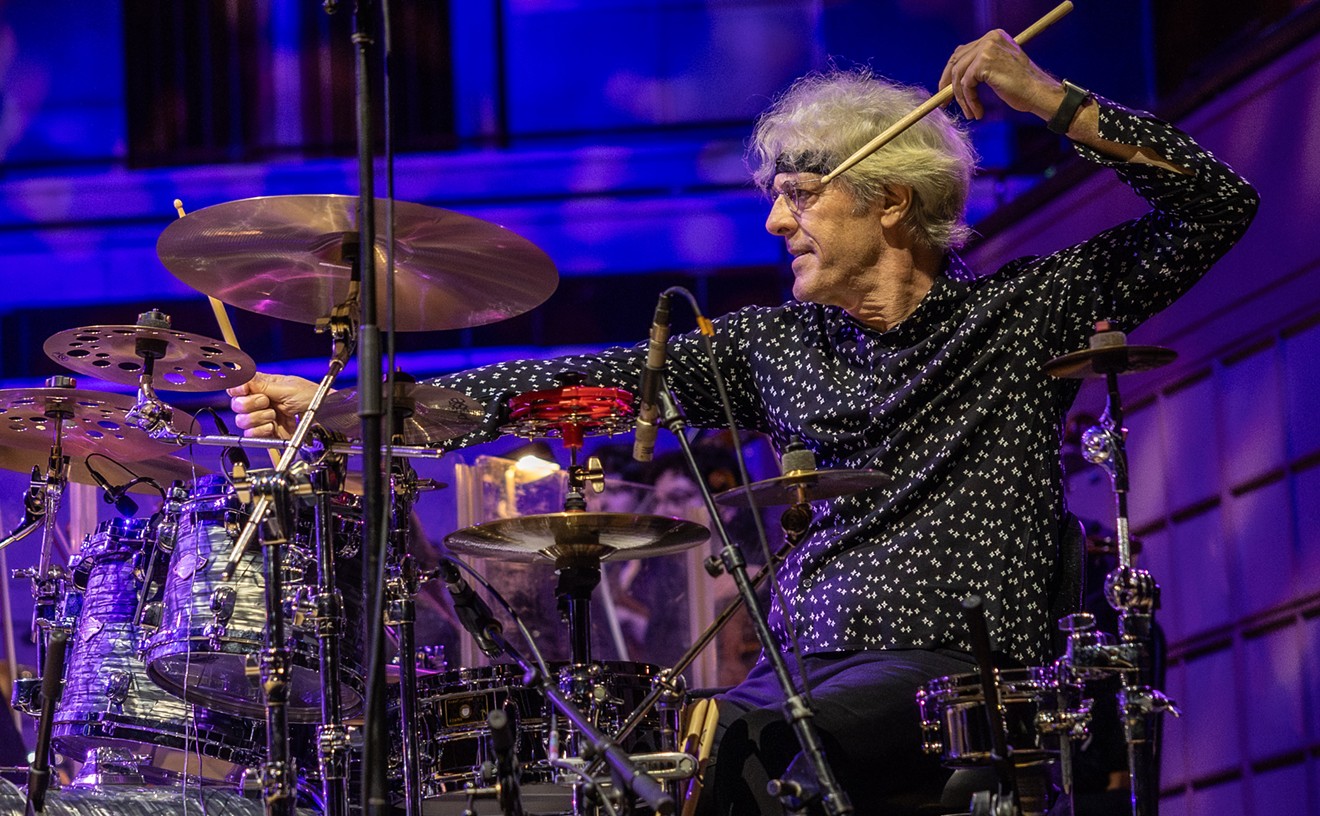But the light-bricked walls of the club do house a palace, of sorts. The joint itself is visually unremarkable, decorated by dated Budweiser advertisements and music posters of long gone artists and shows, including RL's original club. Like any royal court, the old-school trappings amplify the feeling of history, of continuity, of culture. Here, the blues is still king.
Owner RL Griffin, leading the house band, steps offstage and howls lyrics as he walks between the long tables. The band's timing is at this point so engrained it could likely play the tunes while asleep.
Married couples dance antiquated moves. The waitresses make it no secret that they're competing for business, shamelessly feuding with each other within earshot of their customers.
Although it's a far walk from Deep Ellum, RL's Blue Palace is much more representative of what that area was in the 1930s — a nationally renowned haven for authentic blues.
Dallas' blues players of the first half of the last century, who honed their craft in an emerging genre, founded the Texas blues. T-Bone Walker, Lead Belly, Blind Lemon Jefferson, Lightnin' Hopkins and Freddie King created sounds and techniques which had a profound effect on both rock and folk-rock music. Jefferson, who was discovered busking on a street corner in Deep Ellum, was one of the most influential players of the blues' acoustic era. When the blues went electric, King was one of its most renowned guitarists, and his biggest acolyte was Eric Clapton.
But the biggest of all in Dallas blues was T-Bone Walker. Chuck Berry, who's known as the father of rock 'n' roll, was heavily influenced by Walker, as was B.B. King. And while most people think of Jimi Hendrix as the first guitarist to play strings with his teeth, the trick was originally Walker's. It seems like no matter the blues guitar, all licks lead back to T-Bone — and to Dallas.
RL Griffin's understated club is often seen as the last stand for those who appreciate Dallas' influence on the blues. But an observant visit to present-day Deep Ellum shows that the genre is alive and kicking fervently among a young group of burgeoning blues, folk and soul artists.
At the head of the pack is Leon Bridges. Just this past year, the young singer from Fort Worth struck a melodic chord around the world with his irresistible brand of soul. While others adopt retro gimmicks, Bridges is channeling Texas music heritage in a more authentic, convincing way. And his devoted identification with North Texas is putting the area back on a map that it somehow lost. "Before all this, I love where I'm from," he tells the Observer. "I'm always gonna be a Texas boy."
Bridges is just one of the Dallas musicians, along with crusaders who are bringing needed attention to forgotten landmarks, who are forming a vanguard of cultural revivalists. As they inform an oblivious DFW of its shining musical past, they remind us that our city can proudly compare to music meccas like Memphis or New Orleans.
Delta Blues-inspired singer Charley Crockett, returning home after busking coast to coast, found Dallas ready for his sound. As North Texas regains recognition for its outpouring of roots-oriented music, he too is finding success in his hometown.
Crockett amassed a fan base that follows him whether he plays at a taco stand or at the Kessler. His single "I Am Not Afraid" just played on National Public Radio, and the release show for his sophomore album, In the Night, took place recently at the historic Granada Theater. Crockett showed up to the show in a vintage Cadillac.
"Dallas is known as the city that killed Kennedy more than one of the most famous blues cities in the world," he says. "I think we're changing that because of people coming up now, having pride in that heritage, using it to shape the sound that music is gonna break from."
Bridges, who's been particularly vocal about Crockett and country-folk singer Vincent Neal Emerson, says that he's inspired by his hometown peers. "I just recently listened to Charley's record and it's very solid," Bridges says of Crockett. "That was encouragement for me to stay consistent. ... For me it's really encouraging to see other guys my age writing great songs with the outfit of classic and traditional music."
Emerson further credits Crockett for honoring a rich musical legacy. "I think we're this far in society that people my age are looking back at old music and it seems more real. We, especially Charley, are taking away from that old stuff and adding something new and unique," Emerson says."Every artistic form benefits from looking back. If the British revivalists hadn't gone back into old blues, rock n' roll would've sounded very different."
tweet this
Crockett, Bridges and Emerson convey a consistent alliance of mutual support and influence, forming a benign music scene triumvirate. Behind them are a group of many young local musicians who represent varying genres, like Jamie Vahala, Jenna Clark, Ginny Mac, Garrett Owen, Cody Foote and Elizabeth Riley, to name a few, while adhering to a classic aesthetic and old-time influences.
But it's chiefly Crockett who seems to be on an endless chase for cultural preservation, expressing that he's saddened that DFW's unique musical history has been lost in a consumerist world. He ascribes the city's neglect toward its musical past to racism. "Part of Dallas' amnesia toward its musical history is rooted in its racial divide," he says. "History doesn't repeat, but it rhymes. ... The young generation has a lot of problems, but we are the least racist generation in American history. Our future is not what the baby boomers say it is. When shit gets that caught up, we have to look backward."
Crockett also draws a correlation between old blues and modern-day hip hop: "It's no coincidence that both Leon and I were influenced early on by hip-hop. That's how I connected back to old blues music," he says. "That's where the protest, the soul, the honesty and struggle is."
Crockett relates feeling a sense of responsibility to represent the area's rich heritage and the effect that it's had culturally, and laments that Deep Ellum interlopers are unaware that they're stepping on the same streets as T-Bone Walker, Bessie Smith and Ma Rainey. He goes on to list all the long-gone musicians from the area who have inspired him, including Blind Lemon Jefferson and Walker, calling them "platform changers who changed their genre and reinvigorated their movement."
Crockett believes that a pervasive resistance against the bleakness of the digital age drives the art community, and likens Dallas visual artist Joonbug to the socially-conscious street artist Basquiat. Crockett adds that there's an inherent rebellion to creating authentic roots music, much like Janis Joplin did in the '60s, whether it's blues, soul or country. "Look at the response that Leon's had with his songs," he says. "What's he gonna capture? It's God, that's what that is. It reminds people of a time when music seemed pure."
If one place in Dallas can claim the purity of its distinguished ghosts, it's the building referred to as "508 Park." This Art Deco relic, which sits in the downtown intersection of Young and Park, has seen its share of Dallas history.
The warehouse, which is mid-reconstruction, was once a movie distribution center owned by Paramount, in an area then referred to as "Film Row." Between 1930 and 1960, it belonged to Warner Brothers, and as the space contained idle recording equipment, it was put to use by legends like Gene Autry, Bob Wills and the Texas Playboys.
And it was here that blues legend Robert Johnson cut some of his most iconic recordings.
Johnson essentially shaped rock music by inspiring the likes of the Stones and Eric Clapton. But back in the 1930s, he was relatively unknown. Johnson, a native of Mississippi, is a mythic figure in the blues: Legend has it he sold his soul to the devil and he died at the age of 27, allegedly poisoned by a jealous lover. His recorded output — totaling only 29 songs, roughly half of which were recorded in Dallas at 508 — defined the Delta blues.
The 508 building sat abandoned for thirty dusty years until nonprofit group Encore Park Dallas purchased it. Its executive director, Pat Bywaters, describes his plans to re-open the space as an "arts mecca," likening its significance to famed studios like Muscle Shoals or Sun Records.
The restoration of 508 aims to not only reestablish the scope of Johnson's influence, but to awaken local interest in the significance of DFW's blues legacy. "Worldwide, you have groups of people who care a lot about the American music story," Bywaters says. "For me personally, I've had a deep love of music fundamentally rooted in the blues. With this project, I just happened to be one of the people standing there either at the right or the wrong time, however you wanna look at it."
Bywaters' project must navigate the funding (private sources, raised locally) and the guidelines of the Historic Landmark Commission to come to life. He's had to enlist a historic paint analyst to restore the building to its original appearance. "I think the preservation of the building is important for its musical history, its architectural history, and for the younger generations to be aware of that past," Bywaters says. "Every artistic form benefits from looking back and seeing what's been done. If the British revivalists hadn't gone back into old blues, rock 'n' roll would've sounded very different."
While the building isn't yet open to the public, they've been hosting live shows outdoors in a medium-sized amphitheater with a colossal sound system. A lone red brick contrasts with the stage's white wall. It was transplanted from inside the studio's walls as a witness that "heard" all the original recordings. "That was my crazy idea," Bywaters says.
At 508, the removal of four inches of concrete is underway, flaunting a teasing slice of sparkling tile floors. While preserving significant details, like the original Warner Brothers sign on the rooftop, the building's three stories are slated to be converted into a museum of street culture and a coffee shop, an interactive gallery, a recording studio and a rooftop event space. There's already a tidy community garden built mostly by the homeless community residing in the Stewpot, across the street.
Bywaters plays samples of music on the third floor of the gloomy and sticky-hot haunt, in the actual spot where he estimates that Johnson and Wills once stood recording, while explaining the process. "People had to choreograph a mix back then by stepping away from the microphone," he says. "Just about every ethnic group was represented here through recordings."
In the damp basement, once a boiler room and later a printing room, are the remains of a small bathroom, once designated for "coloreds." It now stands as a symbolic reminder of the fact that, as Bywaters surmises, even a musician of Johnson's current stature would've been relegated to a boiler room bathroom.
"There are great stories in that musical history that we need to hear, regarding racism and Jim Crow," Bywaters says."The building provides a physical place that connects the stories to where the musicians came together."
Bywaters says that most people in Texas were unaware of Johnson's existence until 1961 when Columbia Records reissued his music, which moved people like Bob Dylan, as well as rock musicians in England. "He was almost completely a historical accident, he could've been easily forgotten," Bywaters says, of Johnson.
Traditionalist musicians enjoy several friendly venues in Dallas. They've nested on the newer stages of The Free Man and Twilite, but they seem exceptionally suited to the Kessler, the sonically blessed Oak Cliff venue with loyal patronage and a conscious habit of pairing local and national acts.
Current owner Edwin Cabaniss is an investor whose particular fondness for restoring old buildings sprung from volunteering to help build houses after 9/11. "Most of my investments before that were only on paper," he says.
Cabaniss finds that, especially in the case of repurposed venues, embracing the past enriches the future of artistic communities. "Outside of my family, preservation, the arts and neighborhoods are my passion," he says. "These buildings have a very colorful, checkered past, but when we commit to doing them, we feel very strongly that they have a bright future as well."
Cabaniss originally bought the Kessler to accommodate his wife's dance studio in 2009, and decided to turn it into a live music space on the days it was unoccupied. He appointed Jeff Liles as artistic director, who at that time was managing the famed Los Angeles club The Roxy.
Liles relates that the building has been reincarnated throughout the eras. Once a movie theatre owned by Gene Autry, it survived a tornado hit in the 1950s, caught fire in the early '60s, operated as a church, an upholstery shop, and then laid empty for 14 years. "When you've got something so elegant and so historical, somebody needs to come along and give it life again," Cabaniss states. "You need to resurrect it, but also make it thrive. Now the Kessler is as good as its neighborhood."
The venue took seventeen months to rebuild. It had to be gutted and its slanted floor leveled. During its first year, it had no marquee (and no phone), but now proudly flaunts a replica of the original, further adding character to the Kessler's historic surroundings. As Liles says: "The area is militant about keeping buildings the way they are."
Local musicians consider playing the Kessler an honor. Liles ascribes this mostly to the fact that its stage doesn't host many concerts, instead featuring a variety of burlesque and swing dance nights. "Each side of downtown has its own stereo reclamation project," Liles says. "There have been so many amazing artists that have come from Oak Cliff ... Stevie Ray [Vaughan], Edie Brickell. Deep Ellum is more urban, gritty, everything is close to each other. In Oak Cliff it's a nice neighborhood feel, it's casual. People come to the Kessler because it's a very different experience than going to a corporate live music venue."
While he doesn't dismiss any genre, Liles' unspoken criteria for booking acts is whether they'd be able to entertain a room in the event that the electricity were to go out in the building. This favors purist artists such as Leon Bridges, Charley Crockett or Jenna Clark. "Someone like Leon wouldn't have any problem strapping on a guitar, sitting down at the foot of the stage and singing a song; neither would Charley," Liles says.
He also finds a parallel between the renewed nostalgia for the Kessler and Bridges' popularity. "He appeals to people of all ages, essentially. It's not processed, it's not gimmicky, it's a total throwback to a time when records were made in a day. These days it's a piecemeal project of creating a product instead of creating a moment," Liles says. "Charley has that same kind of appeal, too. "
Crockett got a standing ovation on his first performance there, as an opener. Liles says he taps into something deep in the nation's psyche. "For one thing, it's cultural Americana," Liles says, "It's what America sounds like, it's a slice of life. It's throwback, a nod to that, but it's purist in that sense."
Cabaniss has recently acquired and reconstructed The Heights Theater in Houston, which is also in a historical area, and is slated to open this coming October. He finds that, through the many challenges that preservation imposes, the main difficulty lies in meeting modern demands for parking, and the Houston neighborhood was equally welcoming as Oak Cliff. "We really enjoy the juxtaposition of presenting new art in a historic setting. We're very proud of what we were able to do in Dallas, and hope we are on the same path in Houston," Cabaniss says. "It's a universal trait, people care about these projects, and the history of these buildings. When it really works, it's magical."
Few names evoke virtuosic guitar playing more immediately than "Stevie." Stevie Ray Vaughan is an indisputable legend, an icon of blues whose showmanship influenced seemingly everyone who plays guitar, or even air guitar. He died tragically in a helicopter crash at age 35.
Vaughan was born, raised and buried in Dallas, and one would assume, would be an endless source of local pride. Yet, over 25 years have passed since his death, and the city hasn't held as much as a sticker commemorating his birthplace. The guitarist spent some of his working life in Austin, and even they had the decency — and savvy — to erect a memorial statue. Overlooking Vaughan didn't sit well with the guys at the Kessler Theater, and through their joint efforts with Kirby Warnock, set out to do right by Stevie by giving him the respect due, through the construction of a memorial to be placed near his old home in Oak Cliff.
Warnock is the former editor of Buddy magazine and the director of When Dallas Rocked, a documentary which explored the city's flourishing music scene during the '60s and '70s. Warnock led the effort to place a statue of Stevie Ray and his brother Jimmie Vaughan in Kiest Park, two blocks away from the blues players' old childhood home in Oak Cliff.
He first secured the surviving Vaughan's permission, and then had to raise the $64,000 requested by the city. The Kessler put on a benefit show featuring Smokin' Joe Kubek and Jim Suhler. Warnock says he received support for the project from people all over the country, and that significant funding was raised by auctioning off signed guitars donated by Eric Clapton and Steve Miller.
Artist Casto Serrano's design won among countless submissions, and the memorial is due to be unveiled next summer. The tall, see-through depiction of the Vaughan brothers should stand alone as an intriguing modern work of art. The Vaughan statue will be the first in Dallas protected as city property. "We did a terrible job of preserving our history," Warnock says. "While other cities take care of them, Dallas is too quick to turn down its own buildings." He believes the city is overly concerned with flaunting its commercial achievements rather than its unique musical culture. "We have statues to business men, but not a single one of our creatives," he says.
Warnock, who has a history degree from Baylor, says he is particularly concerned with oral tradition and preserving cultural history. He gives credit to other preservationists like George Gimarc of the Texas Musicians Museum and Pat Bywaters with 508 Park, who are also crusading to pull DFW out of its oblivion toward its musical heritage. "Dallas is the birthplace of Texas blues. We have five guys from Dallas in the Rock & Roll Hall of Fame; I don't think Austin has that many," he says.
Stevie Ray Vaughan is also a primary example of the legacy of Dallas blues coming full circle. As artists like T-Bone Walker emerged in Dallas simultaneously with the Delta blues in the '30s, their sound went on to shape the rock music coming out of '60s England, bands who in turn influenced Americans such as Hendrix, who influenced Vaughan, whose style was, and still is, wildly imitated, even by his own predecessors.
"The Vaughans made the blues accessible to suburban audiences," Warnock says. "We have a huge legacy of great guitar players. We don't need to create a history, we've already got it. We just need to claim it."
Charley Crockett sees his generation attempting to finally bring this home to North Texas. "I'm sure Stevie would have done that if he hadn't died so young," he says. "He embodied that Dallas pride."
Charley Crockett takes the stage on a hot, late-summer night over Labor Day Weekend, keeping an eye on someone in the audience: Leon Bridges. Equipped with his ever-present fedora and flip-up sunglasses, Crockett is headlining the free show. It's a packed house at The Rustic in Uptown, where Crockett is playing a pre-party show for the Dallas Observer BrewFest.
Bridges, dressed in vintage slacks and a button-up shirt that's buttoned even at the cuffs, even in the heat, hardly acts like an international phenomenon. He's seated not back stage or anywhere out of view of the masses, but down among his fans at one of the many picnic tables.
"Yo, Leon, man, I ain't trying to call you out," Crockett says, to wild cheers from the audience. "I just thought maybe you'd want to get up here and do the blues with us or something." Bridges, showing typical humbleness, refuses on stealing the spotlight.
In 2015, the 27-year-old Fort Worth singer became a new icon of old soul music. In the span of 12 months, he signed to a major label, performed on late night TV, did a show for the president at the White House, sold out the Apollo Theater, and received a Grammy nomination.
More than just a convenient tie in with his Coming Home album title, Bridges' whole narrative has been centered around where he comes from. "Leon and what’s happened to him here does help," says Chris Vivion, of Fort Worth's Niles City Sound, the studio where Coming Home was recorded. "He puts 'FW' on everything. So there’s kids at Fuji Fest in Japan seeing Fort Worth on a big banner behind an artist that they really like. So that’s just in their heads now: 'Cool, well that’s a place where cool music happens.'"
For all the hope and hype, Bridges admits he's not studied in DFW musical history. "I don't really know all the history in Dallas as far as blues musicians because I grew up listening to nothing but '90s R&B music, and when I got out of that and started exploring soul music and blues I definitely started to look in that area," he says. He pauses to think, then turns to his crew to ask, "Freddie King was from Dallas, right?"
But while Bridges isn't as studied or devoted to the blues as Crockett, he shows support for the local scene. He'll jump on stage with local musicians, or even busk with them on the streets of Deep Ellum. "I see it like God has given me a voice and a platform, and I'm always forever grateful for that, so I think how I can use that to shine a light on somebody else," he says. "And people pay attention to me, which is weird."
Back at The Rustic, the crowd is paying attention to Bridges, and they won't let him sit passively by while Crockett asks for his help. Deciding to take matters into their own hands, those around him, including fellow musicians like Vincent Neil Emerson, grab Bridges and escort him to stage. Seemingly embarrassed as he approaches the mic, Bridges gives Crockett a hug, and the friends whisper in each others' ears before playing a couple songs together.
Bridges is surrounded by fans, friends and family members, but in Dallas, just like in his hometown of Fort Worth, they're nearly indistinguishable. Bridges is also — inadvertently or not — filling a role for an area with a neglected musical history. Like it or not, he's been drafted to be the local hero needed to inspire the area to unearth its musical roots.











